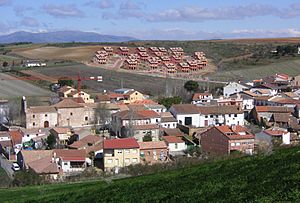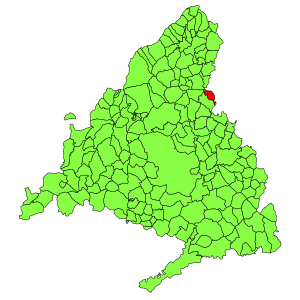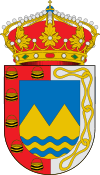Valdepiélagos facts for kids
Quick facts for kids
Valdepiélagos
|
||
|---|---|---|

View of Valdepiélagos
|
||
|
||

Municipal location within the Community of Madrid.
|
||
| Country | ||
| Autonomous community | Community of Madrid | |
| Comarca | Campiña Madrileña | |
| Area | ||
| • Total | 679 sq mi (17,59 km2) | |
| • Land | 679 sq mi (17,59 km2) | |
| Elevation | 2,441 ft (744 m) | |
| Population
(2018)
|
||
| • Total | 574 | |
| • Density | 8,410/sq mi (32,46/km2) | |
| Time zone | UTC+1 (CET) | |
| • Summer (DST) | UTC+2 (CEST) | |
Valdepiélagos is a small town, also called a municipality, located in the Community of Madrid, Spain. It became known as a "villa" or town on May 3, 1801.
Contents
What's in a Name? The Etymology of Valdepiélagos
The name Valdepiélagos has a bit of a mystery around it. Experts who study languages and history have come up with two main ideas about where the name came from.
Valley of Many Waters
One idea is that Valdepiélagos means "valley of many waters."
- Val is an old way of saying "valley."
- De means "of."
- Piélago is a poetic word for a sea or ocean. In this case, it means a lot of water.
So, if you put it all together, it sounds like a place with lots of streams or rivers.
Valley of Skins and Lakes
Another idea connects the name to how people used to live.
- Long ago, people from a nearby town called Talamanca de Jarama might have used this area to dry animal skins in the sun.
- This theory suggests the name comes from val (valley) + de (of) + piel (skin in Spanish) + lagos (lakes).
This makes sense because many towns in the area were named after the goods they produced or traded.
Where is Valdepiélagos? Location and How to Get There
Valdepiélagos is located in the northeast part of the Community of Madrid. It shares a border with the province of Guadalajara to the north and east. To its south and west is the town of Talamanca de Jarama.
Getting to Valdepiélagos by Road
Two main roads go through Valdepiélagos:
- The M-120 road runs from Mesones to Talamanca de Jarama.
- The M-125 road comes from El Cubillo.
If you are coming from the city of Madrid, you can take the A-1 motorway towards Burgos. Then, take Exit 50 to get onto the N-320 road, which goes towards Guadalajara. If you are coming from Guadalajara, you would take the N-320 in the opposite direction.
Bus Connections
The village is also connected by bus. You can use parts of line 197, which goes from Madrid (Plaza de Castilla) to Torrelaguna. There is also line 197 E, which connects Talamanca de Jarama, Valdepiélagos, and Torrelaguna.
Valdepiélagos Weather: Climate Information
Valdepiélagos is 744 meters (about 2,440 feet) above sea level. Its location in the middle of the Iberian Peninsula gives it a specific type of weather called a continental climate.
Summer and Winter Temperatures
- Summers are hot, with average temperatures around 24°C (75°F). High temperatures can go above 35°C (95°F).
- Winters are cold, with average temperatures around 5°C (41°F). It gets chilly, but there isn't usually a lot of snow.
Spring and autumn have milder, more comfortable temperatures.
Rainfall
The rainy season in Valdepiélagos is from spring to autumn. On average, about 530 liters of rain fall per square meter each year.
Plants and Trees: Vegetation in Valdepiélagos
The plants and trees in Valdepiélagos are varied. They are typical for central Spain, matching its continental climate.
Countryside Plants
The countryside is mainly covered with:
- Thickets (dense groups of bushes)
- Gorse bushes
- Thyme
- Rosemary
- Lavender
- Bramble (like blackberry bushes)
Plants Near Water (Riparian Vegetation)
Near rivers and streams, you will mostly find:
- Black poplar trees
- Willow trees
There were also many elm trees, especially a large group at the entrance to the village. However, most of these elm trees were lost in the early 1980s due to a disease called DED.
Farm Plants: Crop Vegetation
The main crops grown in Valdepiélagos are:
These are grown in that order of importance.
How Valdepiélagos Makes Money: Economy
The economy of Valdepiélagos relies on a few main activities:
- Farming (Agriculture): Farmers grow crops like wheat, olives, and barley.
- Animal Farming (Animal Husbandry): This used to be bigger, but now only one flock of sheep remains.
- Shops and Services (Trade): There are local businesses like a bakery, a butcher shop, a car repair shop, supermarkets, and bars.
- Other Businesses: This includes things like construction and SMEs (small and medium-sized businesses).
See also
 In Spanish: Valdepiélagos para niños
In Spanish: Valdepiélagos para niños



